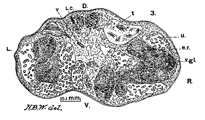Parasitology, Harold W. Manter Laboratory of

Studies from the University of Nebraska Zoological Laboratory
Date of this Version
8-1-1897
Abstract
The intimate relations in which domestic animals stand to man have always made the transfer of parasites from the one to the other a matter of much greater probability than exists between man and the other forms of animal life. It is but natural that the most common species of human tapeworm come to man from his two chief sources of animal food-beef and pork. The chances of accidental infection, however, are evidently much greater in the case of those forms that are intimately associated with man, and hence clearly greatest in those he holds as household pets,the dog and the cat. It is also evident that the chances of parasitic infection are greatest in the case of those peoples or individuals who live on terms of closest intimacy with these domesticated forms. Thus, the Icelander, who is known to permit his dog to occupy, not only the same room, but even the same bed with himself, is most seriously troubled with the parasites common to dogs and man, and the infant or child is more likely to be infected than persons of maturer years. It becomes, then, a matter of great importance to determine in any region or community what is the average percentage of these animals infected with parasites, since, as will be evident later, the percentage of infection varies widely in different regions. It is, however, by no means a matter of indifference what parasites occur in the dogs or cats of a specific locality, for certain of the species are entirely harmless to the human race, not being known to be at home in man at any stage of his existence, and certain species are comparatively harmless, even when present, while certain others are the causes of grave disorders. among them the most serious parasitic disease which is known.
Included in
Parasitic Diseases Commons, Parasitology Commons, Zoology Commons


Comments
Published by Nebraska State Medical Society.